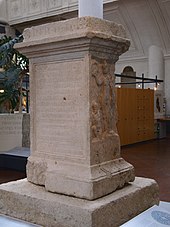Consecration stone
A consecration stone or votive stone , in the narrower sense, was a stone in which, in ancient times, an inscription to deities, kings or high-ranking personalities was carved.
The oldest consecration stones come from Babylonia and are called Kudurru . Also known is the consecration stone of the ancient city of Thera on the Greek island of Santorini , where several stones with the names of gods carved on the ground were found in the lower town, dating from the 7th century BC. Come from BC.
Roman stones were mostly made in the 1st to 3rd centuries AD. They are particularly important evidence of the Celtic religion , but they are also important witnesses for the continental Germanic religion of Roman times .
In a broader sense, stones with a consecration are sometimes still called consecration stones and are known from many other cultures.

